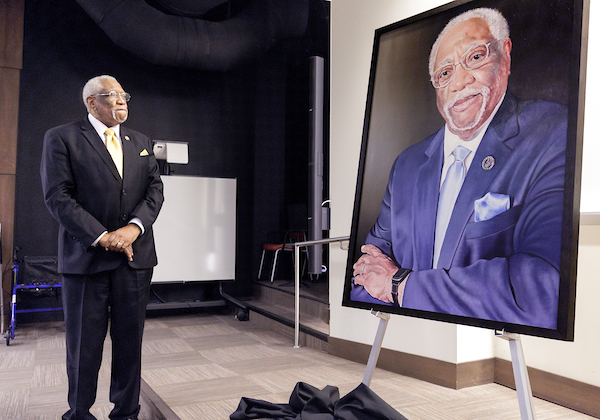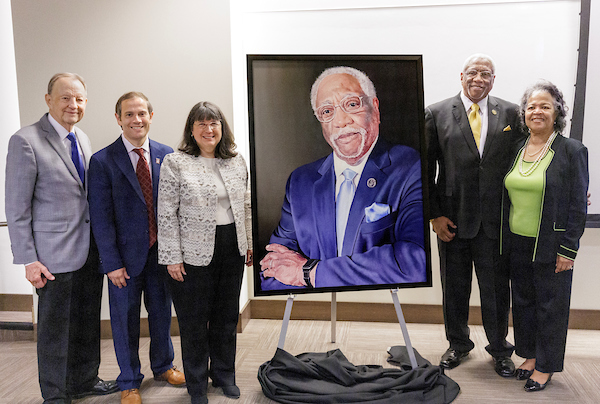UA Little Rock Honors Vice Chancellor Emeritus Charles Donaldson with New Portrait

The University of Arkansas at Little Rock honored one of the university’s most influential administrators with a new portrait that was unveiled Oct. 3 in the building that bears his name.
The portrait of Dr. Charles Donaldson, vice chancellor emeritus and emeritus associate professor of higher education, will hang on the first floor of the Donaldson Student Services Center.
This building, which was renamed in honor of Donaldson in 2014, is one of many building projects that resulted from his leadership during his career, including the expansion of the Donaghey Student Center, dormitories, and the Trojan Grill.
“The crowning accomplishment was the culmination of his dream to build a one-stop shop for student services,” UA Little Rock Chancellor Christina S. Drale said. “There can be no doubt that Charles Donaldson has the heart of a Trojan and models all the values we hope to instill in our students. He has a legacy of raising students up and giving them a chance in the world.”
Starting at UA Little Rock as a counselor in 1973, Donaldson rose through the ranks to become vice chancellor of educational and student services. He also served as director of career planning and placement, associate vice chancellor for educational and student services, and dean of University College.
“I stand this afternoon humbled and grateful for the honor and privilege,” Donaldson said. “My path has been one of a servant. I viewed myself as one who was destined to make a difference in the lives of the people I encountered. I am blessed beyond measure for the opportunities I’ve been provided. I am grateful for the work that has gone into making this day possible.”
His leadership expanded key programs, such as Cooperative Education and TRIO, securing over $16.5 million in federal funding. He was instrumental in creating initiatives like the African-American Male Initiative and expanding the Chancellor’s Leadership Corps.
“Dr. Donaldson is a visionary whose dedication to education and student success has made a lasting impact on our community,” said Dr. Cody Decker, vice chancellor for student affairs and chief data officer.
Chancellor Emeritus Joel Anderson, who worked alongside Donaldson from the 1970s to the 2010s, recalled how hard Donaldson worked to make UA Little Rock a welcoming place for all students. When UA Little Rock was one of the country’s newest metropolitan public universities, this campus was a tremendous blessing for those who were place bound, had families, and needed to work while going to school. Donaldson worked to provide student services to all when nontraditional students were still a new concept in higher education.
“He touched the lives of thousands of students, many of whom would not have entered college or stayed in college or graduated from college had it not been for Dr. Donaldson,” Anderson said. “The portrait unveiling today is a most fitting act by the university. Both the building and the portrait will endure for decades to come, and it is appropriate that they will remind of the man behind the name and of his influence and the magnitude of his impact on the university.”

Dr. Richard Harper, dean of students, met Donaldson when he started at UA Little Rock as a graduate student 13 years ago. He described Donaldson as an effective leader, visionary, and communicator who always commanded respect and put students first.
“He had high expectations for not only his staff but students as well,” Harper said. “He developed the mantra that students are the most important people on campus and without them, there would be no need for the institution. He lived by this mantra and used it to guide his work.”
Ray Parker, the artist commissioned to create Donaldson’s portrait, said that he gained a friend for life while working with Donaldson to capture his likeness.
“I quickly came to see Dr. Donaldson as a strong, kind, understanding leader, a man of conviction, a man whose commitment to the University of Arkansas at Little Rock remains steadfast after more than 40 years of service to this institution, its students, and this community,” Parker said. “All of these attributes I tried to capture and bring to life in my portrait of him. It’s a symbol and reminder of a life well lived in service to higher education and the students who will walk past this painting every day.”
